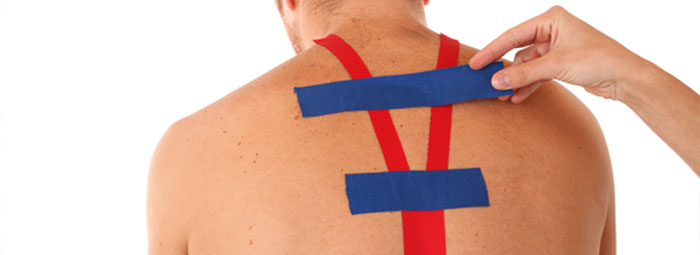 Kinesiology taping – an innovative physiotherapy treatment & technique from Paragon Physiotherapy
Kinesiology taping – an innovative physiotherapy treatment & technique from Paragon Physiotherapy
Kinesiology taping (or kinesio taping) is the application of a thin, stretchy, cotton-based therapeutic tape that can benefit many different injuries and inflammatory conditions. The Kinesio tape we use is always Tex Gold FP which has a unique glue pattern that mimics that of a fingerprint. This design is supposed to make wearing the tape easier. It is hypoallergenic and latex free and made from high grade cotton making it easier for us to use and for you to wear. The weave of the cotton is designed mimic human skin in both thickness and elasticity, which allows it to be worn without binding, constricting or restriction of movement.
Kinesio taping has actually been around for many years but came to most people’s attention due to sporting events like the Olympic Games.
You would have noticed that more and more professional athletes use kinesiology tape to improve their sporting performance.
Kinesiology taping can have some incredible effects for some injuries and conditions.
You won’t believe how effective Kinesio taping is until you try it.
How is Kinesiology Tape Different from Conventional Strapping Tape?
- Most types of strapping tape are non-elastic. They are strapped around an injured joint or muscle to provide rigid support and restrict movement.
Other tapes can only be worn for short periods of time, after which they must be removed to restore movement and circulation. - Kinesio tape can be worn comfortably for 5 days or more
- Kinesiology tape offers unique elastic properties that allows it to provide dynamic support.
- Due to its amazing elastic properties, kinesiology tape allows movement in the range provided by the physiotherapist..
- Kinesiology tape can be worn during intense exercise, in the shower or even swimming.
So what can Kinesio tape do?
Because it can be left on for up to a week, the benefits from correctly applied Kinesio tape are available to the injured area 24 hours a day. This accelerates the healing process from trauma, injuries and inflammatory conditions.
Kinesio tapes can help with the following conditions, but it must be applied properly to have the desired effect.
1. Pain Relief
By effectively lifting the skin, structures beneath the skin such as the fascia, muscles and lymphatic system can move better and work more effectively.
Physically, the lifting action of the kinesiology tape relieves pressure on pain receptors directly under the skin, allowing for both immediate and lasting relief.
Chronic pain can be improved due to sensory stimulation of other types of nerve fibres.
2. Swelling Reduction
By lifting the skin, kinesiology taping provides a negative pressure beneath and surrounding areas. This allows the lymphatic drainage channels to drain swelling and other inflammatory cells away from the injured area quickly.
3. Lymphoedema Reduction
Based on the same physical lifting principle, kinesiology taping can be very effective in the reduction of lymphoedema providing it is applied in the correct way.
4. Reduced Muscle Fatigue, Cramps and DOMS.
By the same negative pressure theory, exercise and repeated muscle contractions which produce post-exercise by products such as lactic acid are assisted in their removal by Kinesio tape. Lactic acid can cause poor muscle performance, fatigue cramping and delayed onset muscle soreness (DOMS).
5. Assists Weak or Injured Muscles
Kinesio tape can be applied in such a manner as to inhibit a tight or spasmodic muscle or the facilitate a weak muscles to improve its performance
By supporting weak or painful structures, kinesiology tape ultimately allows injured athletes, workers and weekend warriors to return to sport, work or play quicker that without kinesiology tape’s unique dynamic support.
6. Support for Injured ligaments or to restrict painful or unwanted movement
Due to the nature of the tape it can be applied with different degrees of resistance or recoil. This means that at the far end of the scale it can also be used to treat ligament sprains and help with unstable joints such as the shoulder.
